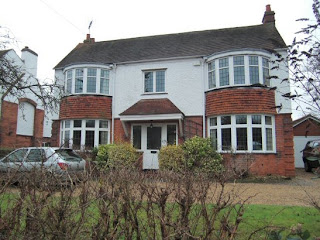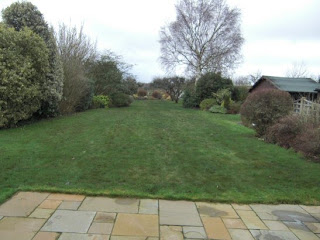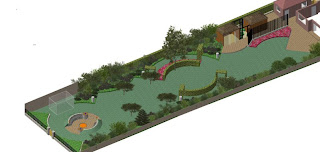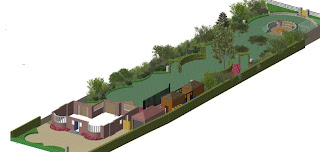
The requirements included a herb garden between an existing summer house and shed, a paved area outside the summer house and planting to help integrate it into the garden. The existing patio was to be extended and the original gateposts, complete with decades of lichen, at the bottom of the garden were to be kept and incorporated into the design. Three ancient apple trees were to be retained and added to if possible. The greenhouse was to stay along with the Fig tree that lives behind it. At the front of the house a new driveway and front entrance to make the front garden more practical and beautiful were required.

I love flint, I was born and raised in Buckinghamshire where it is used everywhere. In this garden all retaining walls are faced with flint and stone. Flint is not only a beautiful construction material; it is widely used in this area as there was a huge flint quarry in Reading. I am going to use Limestone blocks as a frame for flint panels in all the walls. This will blend the garden in with local architecture and look stunning.

I really wanted break the garden up into different areas and give it more personality, impact and a sense of drama. The challenge was to do this without using too much hard landscaping. The new design uses a series of circles that delineate the transitions through the garden and mark out different areas. The circles are linked by 45 degree angle straight lines and asymmetric curves, which combine to give the garden a sense of movement and rhythym, a strong shape that directs attention inwards to various focal points, and also allows the eye to travel to the view beyond the gate.
There are grass paths entered and exited via Hornbeam arches and bounded by Hornbeam hedges. Hornbeam (Carpinus betulus) is one of my favourite hedging plants. It’s tougher and more drought tolerant than Beech, but looks very similar. Hornbeam (like Beech) holds its dead leaves in winter and they make a lovely rustling sound when moved by the wind.

A sunken seating area at the bottom of the garden with built in seats and a fire pit at its centre will provide a sheltered area for a meal or a glass of wine at night. This area will be sunk 45cm below finished lawn level and accessed by three shallow steps. The retaining walls have a circular tower at one end; one wall has its tower at the entrance and the other at the exit. Each tower will be topped with a copper bowl and water will bubble up through the centre of the bowl. Bronze bio-ethanol torches will be placed opposite each entrance/exit tower. Retaining walls and towers will be faced with stone and flint. The outside face of the retaining walls will be finished with a turf mound to blend it into the landscape. These turf structures also give a natural, sculptural finish to this structure and blend it into the overall aesthetic of the garden.

Either side of the existing gateposts at the bottom of the garden there will be a raised bed 60cm high. The retaining walls will be faced with Limestone and flint.
Between the summer house and shed is a small, formal herb garden accessed through a simple wooden arch and screened with trellis panels. The paving in this area is self binding gravel and the beds are finished with a granite sett edging.
The shed is screened by a low wall 45cm high topped with a bespoke screen of 150mm x 25mm wooden planks set at an angle like a large Venetian blind. The wall will be faced with stone and flint. The redundant area to the rear of the shed and summer house will be cleared and widened to provide space and screening for compost bins and water butts.
The shapes from the rear garden are echoed in the front garden. More parking space and kerb appeal is provided by a gorgeous resin bonded gravel driveway. Planting and a new hedge along the front boundary will soften the new driveway. All planted areas are edged with black granite setts. A 60cm high stone and flint faced wall will form the boundary running up to the garage to give the front garden a more elegant look and tie in with the architecture of the rear garden. The front gatepost will be moved to widen the entrance. The gatepost will be faced with stone and flint. The front step and threshold will be paved with traditional Victorian tiles, an echo back to the original period of the house.

If you need help designing your garden please get in touch. You can email me at linsey@linseysgardens.com, all other contact details are on my Web site.
